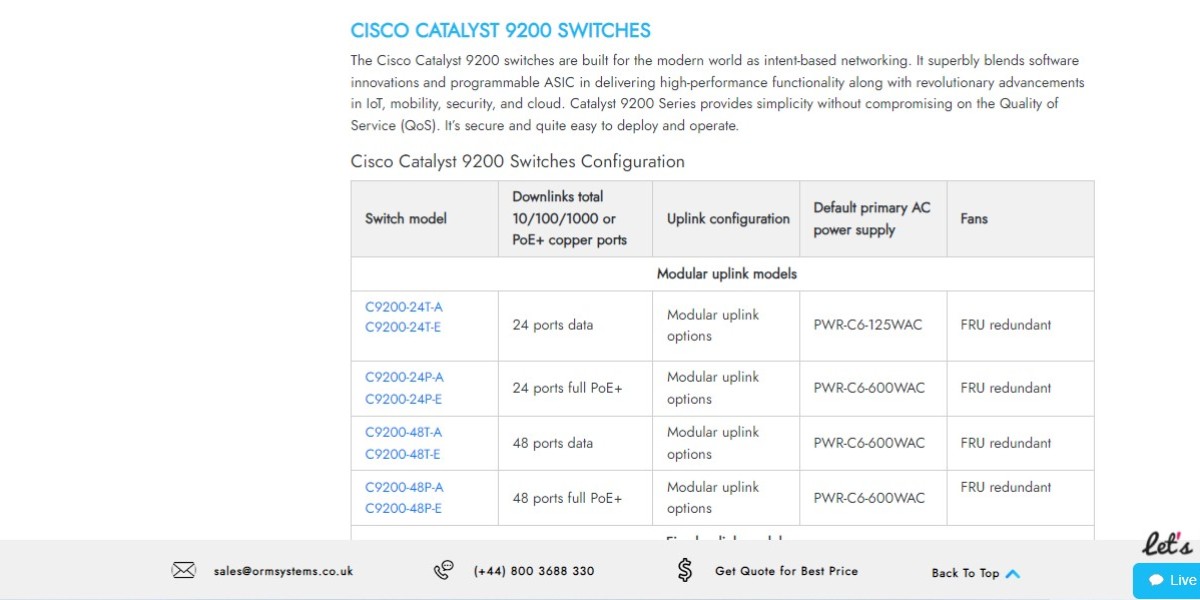Wide Area Network (WAN) performance is crucial for ensuring smooth and efficient connectivity across geographically dispersed locations. The Cisco Catalyst 9200 series switches offer robust features that help optimize WAN performance, providing reliable and high-speed connections. This article outlines best practices and strategies for optimizing WAN performance using Cisco Catalyst 9200 series switches.
1. Understanding WAN Optimization
Key Concepts
- Bandwidth Management: Efficient use of available bandwidth to prevent congestion.
- Latency Reduction: Minimizing delays in data transmission.
- Traffic Prioritization: Ensuring critical applications receive priority over less important traffic.
- Compression and Caching: Reducing the amount of data transmitted over the WAN.
2. Implementing Quality of Service (QoS)
Overview
QoS is essential for managing bandwidth and prioritizing traffic, ensuring that critical applications perform well even during peak usage times.
Benefits
- Traffic Prioritization: Ensures important applications receive the necessary bandwidth.
- Congestion Management: Prevents network congestion by managing traffic flows.
- Improved Performance: Enhances the performance of latency-sensitive applications.
Implementation
Step 1: Define Traffic Classes
shell
Copy code
Switch(config)# class-map match-any CRITICAL_APPS
Switch(config-cmap)# match ip dscp af41
Switch(config-cmap)# exit
Step 2: Create QoS Policy
shell
Copy code
Switch(config)# policy-map WAN_QOS_POLICY
Switch(config-pmap)# class CRITICAL_APPS
Switch(config-pmap-c)# priority
Switch(config-pmap-c)# exit
Switch(config-pmap)# class class-default
Switch(config-pmap-c)# fair-queue
Switch(config-pmap-c)# exit
Switch(config-pmap)# exit
Step 3: Apply QoS Policy to WAN Interface
shell
Copy code
Switch(config)# interface GigabitEthernet1/0/1
Switch(config-if)# service-policy output WAN_QOS_POLICY
Switch(config-if)# exit
Example
shell
Copy code
Switch(config)# class-map match-any CRITICAL_APPS
Switch(config-cmap)# match ip dscp af41
Switch(config-cmap)# exit
Switch(config)# policy-map WAN_QOS_POLICY
Switch(config-pmap)# class CRITICAL_APPS
Switch(config-pmap-c)# priority
Switch(config-pmap-c)# exit
Switch(config-pmap)# class class-default
Switch(config-pmap-c)# fair-queue
Switch(config-pmap-c)# exit
Switch(config-pmap)# exit
Switch(config)# interface GigabitEthernet1/0/1
Switch(config-if)# service-policy output WAN_QOS_POLICY
Switch(config-if)# exit
3. Utilizing WAN Aggregation
Overview
WAN aggregation combines multiple WAN links to increase bandwidth and provide redundancy.
Benefits
- Increased Bandwidth: Combines multiple links for higher throughput.
- Redundancy: Provides failover capabilities in case one link fails.
- Load Balancing: Distributes traffic across multiple links for better performance.
Implementation
Step 1: Configure EtherChannel for WAN Aggregation
shell
Copy code
Switch(config)# interface port-channel 1
Switch(config-if)# switchport mode trunk
Switch(config-if)# exit
Switch(config)# interface range GigabitEthernet1/0/1-2
Switch(config-if-range)# channel-group 1 mode active
Switch(config-if-range)# exit
Example
shell
Copy code
Switch(config)# interface port-channel 1
Switch(config-if)# switchport mode trunk
Switch(config-if)# exit
Switch(config)# interface range GigabitEthernet1/0/1-2
Switch(config-if-range)# channel-group 1 mode active
Switch(config-if-range)# exit
4. Implementing WAN Acceleration
Overview
WAN acceleration techniques such as compression and caching reduce the amount of data transmitted over the WAN, improving performance.
Benefits
- Reduced Data Transmission: Lowers the volume of data sent over the WAN.
- Faster Data Transfer: Speeds up data transmission by reducing the amount of data that needs to be sent.
- Improved Application Performance: Enhances the performance of applications by reducing latency.
Implementation
Use WAN optimization appliances or integrated services routers (ISRs) to implement WAN acceleration features.
5. Enabling IP SLA for Performance Monitoring
Overview
IP Service Level Agreement (SLA) measures network performance and helps identify and troubleshoot WAN issues.
Benefits
- Proactive Monitoring: Detects performance issues before they impact users.
- Detailed Metrics: Provides metrics such as latency, jitter, and packet loss.
- Improved Troubleshooting: Helps identify the root cause of performance issues.
Implementation
Step 1: Configure IP SLA Operation
shell
Copy code
Switch(config)# ip sla 1
Switch(config-ip-sla)# icmp-echo 192.168.1.1
Switch(config-ip-sla)# frequency 60
Switch(config-ip-sla)# exit
Switch(config)# ip sla schedule 1 start-time now life forever
Example
shell
Copy code
Switch(config)# ip sla 1
Switch(config-ip-sla)# icmp-echo 192.168.1.1
Switch(config-ip-sla)# frequency 60
Switch(config-ip-sla)# exit
Switch(config)# ip sla schedule 1 start-time now life forever
6. Optimizing DNS Performance
Overview
DNS optimization reduces latency and improves the speed of domain name resolution.
Benefits
- Reduced Latency: Faster DNS resolution times.
- Improved Network Performance: Enhances overall network performance by reducing delays.
- Better User Experience: Provides faster access to websites and applications.
Implementation
Step 1: Configure DNS Server
shell
Copy code
Switch(config)# ip name-server 8.8.8.8
Step 2: Enable DNS Caching
shell
Copy code
Switch(config)# ip dns server
Switch(config)# ip dns cache timeout 3600
Example
shell
Copy code
Switch(config)# ip name-server 8.8.8.8
Switch(config)# ip dns server
Switch(config)# ip dns cache timeout 3600
Summary of WAN Optimization Strategies
Strategy | Description | Key Benefits |
Quality of Service (QoS) | Prioritizes traffic and manages bandwidth | Traffic prioritization, congestion management, improved performance |
WAN Aggregation | Combines multiple WAN links | Increased bandwidth, redundancy, load balancing |
WAN Acceleration | Reduces data transmission through compression and caching | Reduced data transmission, faster data transfer, improved application performance |
IP SLA | Measures network performance | Proactive monitoring, detailed metrics, improved troubleshooting |
DNS Optimization | Improves DNS resolution speed | Reduced latency, improved network performance, better user experience |
Conclusion
Optimizing WAN performance using the Cisco Catalyst 9200 series switches involves implementing various strategies such as QoS, WAN aggregation, WAN acceleration, IP SLA, and DNS optimization. By following these best practices, you can ensure efficient and reliable WAN connectivity, providing a seamless experience for users and improving the overall performance of your network infrastructure.
ORM Systems: Custom software and IT consulting leaders. Our digital transformation services deliver tailored solutions for business success.


